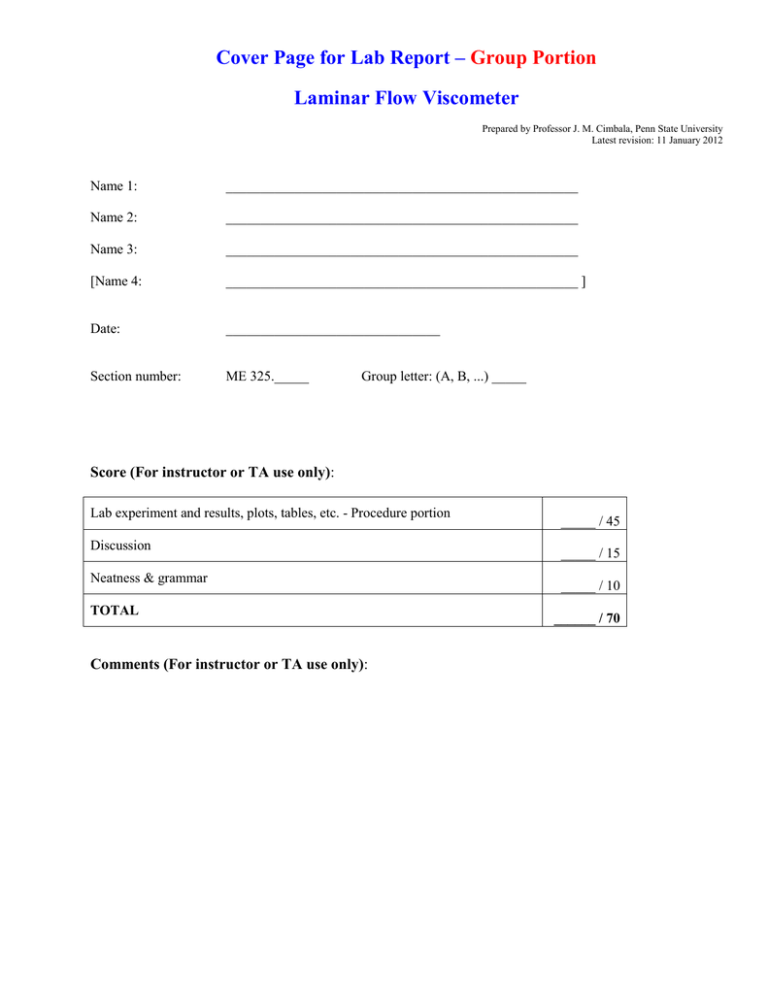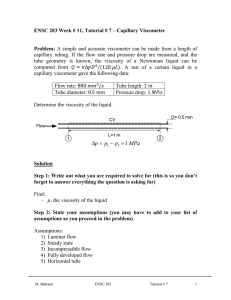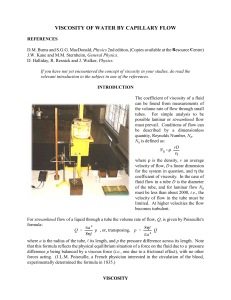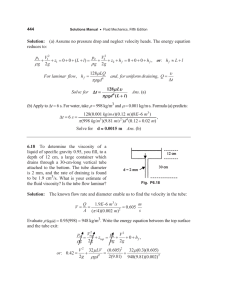Cover Page for Lab Report – Laminar Flow Viscometer Group Portion
advertisement

Cover Page for Lab Report – Group Portion Laminar Flow Viscometer Prepared by Professor J. M. Cimbala, Penn State University Latest revision: 11 January 2012 Name 1: ___________________________________________________ Name 2: ___________________________________________________ Name 3: ___________________________________________________ [Name 4: ___________________________________________________ ] Date: _______________________________ Section number: ME 325._____ Group letter: (A, B, ...) _____ Score (For instructor or TA use only): Lab experiment and results, plots, tables, etc. - Procedure portion Discussion Neatness & grammar TOTAL Comments (For instructor or TA use only): _____ / 45 _____ / 15 _____ / 10 ______ / 70 Procedure and Presentations of Results (8) 1. Before proceeding, make sure the viscometer reservoir and capillary tubes are clean. Blow out the tubes with the air hose to remove dust or other debris if necessary. 2. Get together with your lab partners and, as a group, design a step-by-step experimental procedure for measuring the viscosity of water at room temperature. Be sure to describe in detail how you plan to measure the elevations, the volume flow rate, etc. Make a few trial test runs and refine your procedure if necessary. When your group agrees on the procedure, write it neatly in the space below, and have it signed by your instructor or TA before proceeding further. Note that the accuracy of your results is highly dependent on your experimental procedure. Proposed Experimental Procedure: Instructor or TA’s comments: Instructor or TA’s initials: _______________________________________ Date: ______________ (4) 3. Using room temperature water, a capillary tube of your choice, and the procedure you developed above, measure the viscosity of the water. Hand-tightening should be sufficient to fit the capillary tube snugly into the Swagelok fitting. For best results, repeat the test several times (a minimum of 3 times with the same tube is recommended). This will enable you to determine an average viscosity, as well as give you some idea of the repeatability of the experiment. Also calculate Reynolds number for each trial. If Re D is greater than about 2000, you cannot be sure that the flow is laminar. The flow can be slowed down to ensure laminar flow by draining some of the water from the upper reservoir. Present your results in a neat, well-labeled table, and show sample calculations below. Do one calculation on this sheet and then write an Excel spreadsheet program on the computer program to verify your calculations, and to perform the remaining calculations. Save your file so that you can generate a table of results. At a minimum, your table should have columns for (z1 – z2), d, L, V , t, Q, and . See Table ______ . (2) (4) 4. 5. On the same table, compare experimental viscosity to published viscosity (be sure to indicate the reference of the published data). Also list the percentage difference between the two. The following conversions may be useful: Coefficient of viscosity, Kinematic viscosity, 1 poise = 1 gram/(cms) = 0.1 Ns/m2 1 centipoise = 0.001 gram/(cms) 1 stoke = 1 cm2/s For the case of room temperature water, repeat the test with at least two other capillary tubes. Use tubes of the same diameter, but much different lengths. Record results for each trial in a neat table; include the Reynolds number and a comparison to published data as in Step 4 above. See Table ______ . (15) 6. Based on your results for the room temperature water, select the best capillary tube for the hot water measurements. Measure the viscosity and density of water at several temperatures (at least five temperatures should be used, e.g., room temperature typically around 20oC, 30oC, 40oC, 50oC, and 60oC). Record your results in a table, as before. See Table ______ . (10) 7. Plot dynamic viscosity, kinematic viscosity, and density as functions of temperature. On the same figures, plot the published data from any appropriate reference. See Figures _____________. (2) 8. In the space below, discuss the changes in your procedure (if any) that were necessary for the heated water viscosity measurements. 9. Clean everything and restore all tubes, etc. to their original positions. Discussion (5) 1. For laminar pipe flow, entrance length Le is approximated by the equation Le/D 0.06Red. Is entrance length really negligible in your experiments? In the space below, show calculations of Le for all of your room temperature water cases, and discuss. (5) 2. For the case of room temperature water, you should have results from at least three different length tubes of the same diameter. Which tube yielded the best agreement with published data? Do these results agree with your expectations? Why or why not? (5) 3. Discuss reasons for discrepancies between your results and the viscosity data from the literature. Give suggestions as to how this experiment could be improved.





